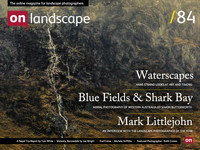Michéla Griffith chooses one of her favourite images

Michéla Griffith
In 2012 I paused by my local river and everything changed. I’ve moved away from what many expect photographs to be: my images deconstruct the literal and reimagine the subjective, reflecting the curiosity that water has inspired in my practice. Water has been my conduit: it has sharpened my vision, given me permission to experiment and continues to introduce me to new ways of seeing.
So how hard can it be to choose a favourite image? Well I guess it depends on how hard you want to make it…..
Having put this off until my summer art shows were out of the way, I now have no good excuse to stall Tim further. The intervening period has at least given me chance to see how others approach the thorny task of picking an image to close “On Landscape” with.
My first reaction was to pull a few obvious contenders off my bookshelf, and I was a little disappointed to draw a blank. I’d find it easier to choose several images to represent the stages in my photographic journey. Ansel Adams (a detail, rather than a vista); Joe Cornish (again most likely a detail or an abstract rather than the views for which he is better known); David Ward – ok a theme is developing here. That for all the attractions of the bigger picture, it is the small things that are so easily overlooked that hold most interest for me.
But much as I might admire these, and others, for their technical excellence, their composition, or their sheer beauty, as my photography has moved on so have my tastes. According to Alan Briot “You know when you are ready to let go” (from emulating the work of others) “when you find your work to be more exciting than the work of the masters”. Well I wouldn’t go that far (much too egotistical a point of view for me to subscribe to) but I do understand the point he was trying to make, and my own journey inevitably has to inform my choice. The images that appeal most to me now leave something to the imagination. They paint an impression. Or convey a mood. Two years of photographing moving water have changed both my technique (from film to digital) and the way I view the landscape. It isn’t static, so why represent it as such? Our eyes jump about – scan the landscape – and our brain connects the visual clues that we pick up on, so why set out to create an image that leaves little to the imagination? Each blade of grass pin sharp. Fore, middle and background in focus. It can be argued that photography allowed painters to become more adventurous and expressive, moving away from photorealism, so perhaps we should aspire to do the same and leave room for the viewer?

